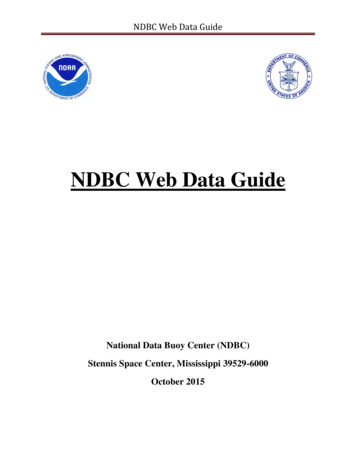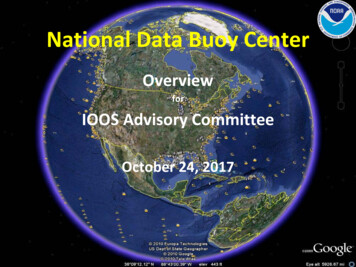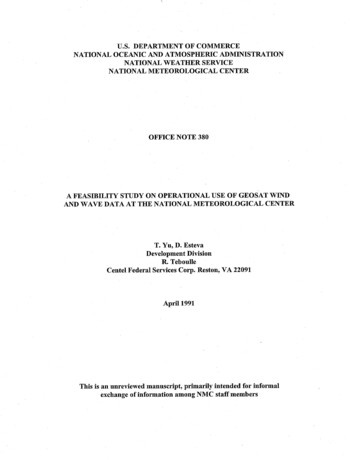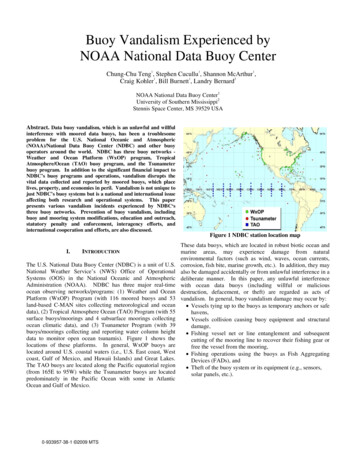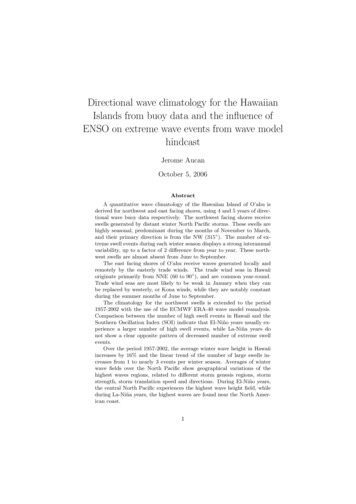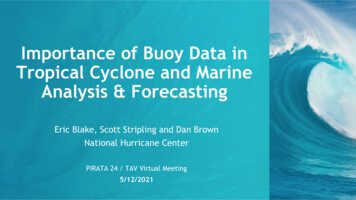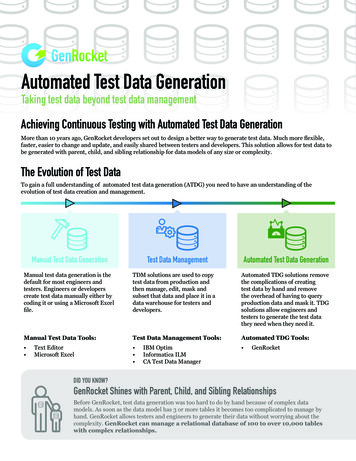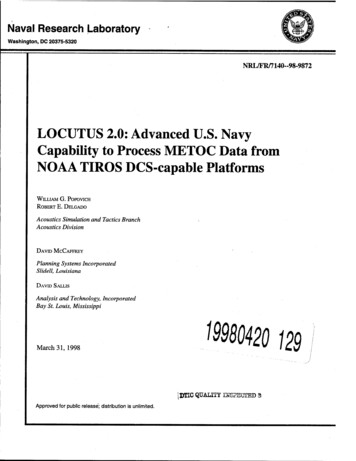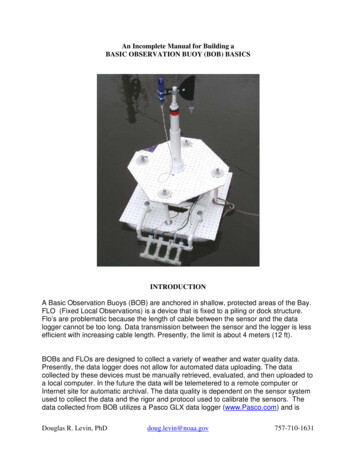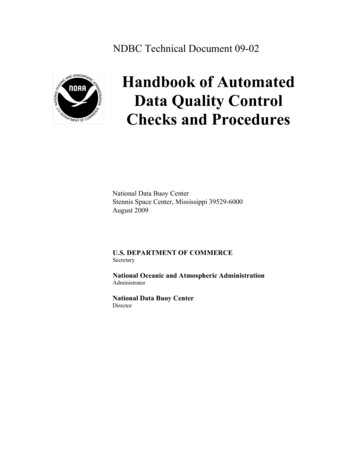
Transcription
NDBC Technical Document 09-02Handbook of AutomatedData Quality ControlChecks and ProceduresNational Data Buoy CenterStennis Space Center, Mississippi 39529-6000August 2009U.S. DEPARTMENT OF COMMERCESecretaryNational Oceanic and Atmospheric AdministrationAdministratorNational Data Buoy CenterDirector
2
TABLE OF CONTENTSGLOSSARY OF ACRONYMS AND ABBREVIATIONS. 61.1.11.21.3INTRODUCTION . 8PURPOSE . 8DATA USES. 9THE NDBC QC PROGRAM . 92.2.12.22.2.12.2.2DATA FLOW AND PROCESSING . 11DATA PATHS. 11REAL-TIME PROCESSING. 13Automated QC . 14Transmission Errors . .2.53.5.2.63.5.33.5.43.5.53.5.6NDBC MEASUREMENTS. 16NDBC PAYLOADS . 16SENSOR HIERARCHY ASSIGNMENT . 17STANDARD MEASUREMENTS . 17Atmospheric Pressure . 17Wind Measurements . 18Temperature . 20Air Temperature. 20Water Temperature . 21Ocean Wave Estimates . 21Non-directional Ocean Wave Estimates . 21DIRECTIONAL OCEAN WAVE ESTIMATES. 24Water-column Height for Tsunami Detection . 25NON-STANDARD MEASUREMENTS . 25Relative Humidity. 25Ocean Sensors. 25Weather Buoy Currents. 26Aanderaa Current Meter . 27SonTek Argonaut MD. 27Ocean Current Profiles. 28Weather Buoy Salinity. 29TAO Ocean Parameters . 29Precipitation . 30Solar Radiation Measurements . 30Visibility . 31Water Level Measurements . 314.4.14.1.14.1.24.1.2.14.1.2.2QUALITY CONTROL ALGORITHMS AND WARNING FLAGS . 31QUALITY CONTROL ALGORITHMS. 32Range Check . 32Time Continuity . 33The Standard Time Continuity Check . 34Time Continuity Algorithm for Special Measurements. 353
.2.144.3.2.15Storm Limits . 36Hierarchy Reversal and Duplicate Sensor Checks. 36Internal Consistency. 37Wave Validation Checks. 38Wind Wave Algorithms . 38Directional Wave Validation Report . 40Swell Direction Check . 40High Frequency Spectral Spikes. 40Wave Height Verses Average Wave Period . 40Wave Direction vs. Wind Direction. 41NCEP FIELDS. 41Continuous Wind Checks . 41Ocean Sensor Algorithms and Checks. 42Aanderaa Current Meter Quality Assurance (QA) . 42SonTek Argonaut MD Quality Assurance (QA) . 43Quality Control of the ADCP Data from NDBC Weather Buoys . 44Quality Control of the ADCP Data from the Oil and Gas Industry. 45Weather Buoy Salinity. 46NDBC FLAGS. 46Hard Flags. 46D Flag — Delete Sensor from NWS Report. 47H Flag — Sensor Hierarchy Has Reversed. 47L Flag — Failed Range Limits Test . 47M Flag — Missing Sensor Data. 47N Flag – Negative Spectral Wave Density . 47R Flag — Related Measurement Failed. 47S Flag — Invalid Statistical Parameter. 48T Flag — Transmission Parity Error . 48U Flag – Discrete Wave Parameters are not valid . 48V Flag — Failed Time-Continuity Test. 48W Flag — WPM Transmission Errors. 48Soft Flags . 48a and b Flags — Above or Below Regional and Seasonal Limits . 48c Flag — Calm Sea State Flag or Corrected Value . 49d Flag — Failed Standard Deviation Check (Continuous Winds Only). 49f Flag — Failed Hourly Time Continuity Check . 49g Flag — Failed Gust-to-Mean Speed Ratio Check . 49i Flag — Continuous and Hourly Wind Speeds Don’t Agree . 49j Flag — Continuous Wind Transmission Error . 49k Flag — Deltas Between Duplicate Sensors Too High. 49m Flag — Failed Spectral Time-Continuity Check(C11) . 49n Flag — Failed NCEP Model Comparison . 50p Flag — Failed Wave Height/Wave Period Check (Wave Periods Only) . 50q Flag — Failed Directional-Wave Algorithm . 50r Flag — Relate Measurement Failed (Continuous Winds Only). 50s Flag — Failed Stuck Compass Check. 50t Flag — Tendency Deltas Between Duplicate Sensors Too High. 504
5.3v Flag — Failed Humidity Verses Visibility Check. 50w Flag — Failed Wave Direction Verses Wind Direction Check . 50x and y Flags — Failed Wind-Wave Algorithm Limits . 51z Flag — Failed Average Bow Azimuth Verses Wind Direction. 51DATA QUALITY REPORTS AND GRAPHICS. 51REPORTS AND GRAPHICS . 51The NDBC Visualization Tools Suite (VTS) . 51The NDBC Plotting Server . 52User Specified Reports . 525.REFERENCES . 54APPENDIX A:APPENDIX B:APPENDIX C:APPENDIX D:APPENDIX E:APPENDIX F:NDBC WEATHER STATION MEASUREMENT IDENTIFIERS . 56RELATIVE HUMIDITY CONVERSIONS . 62ATMOSPHERIC VISIBILITY MEASUREMENTS . 63QUALITY CONTROL ALGORITHMS. 65QUALITY CONTROL FLAGS. 74TSUNAMETER ASCII IDS. 75LIST OF FIGURESFigure 1.Figure 2.Figure 3.Figure 4.Figure 5.Figure 6.C-MAN and Moored Buoy Data Paths Using GOES Satellites . 12C-MAN and Moored Buoy Data Paths Using Iridium Satellites . 13DART II Data Flow . 14NDBC Realtime Processing at NWSTG . 15TAO Data path Using Service Argos/CLS . 30Sample Output from Using Palao-Gilhousen Wind-Wave Algorithm . 39LIST OF TABLESTable 1.Table 2.Table 3.Table 4.Accuracies Achieved During Field Comparisons . 10Statistical Wave measurment Descriptions . 23Default Upper and Lower Limit Values . 33General Values of Time Continuity Limit Values . 355
GLOSSARY OF ACRONYMS AND ABBREVIATIONSADCPARESATLASAWIPSC-MANDACDACTDART CNDBCNEMISNESDISNOAANODCNOSNTSCNWSNWSTGAcoustic Doppler Current ProfilerAcquisition and Reporting Environmental SystemAutonomous Temperature Line Acquisition SystemAdvanced Weather Interactive Processing SystemCoastal-Marine Automated NetworkData Assembly CenterData Acquisition and Control TelemetryDeep-ocean Reporting and Assessment of TsunamisData Acquisition and Processing SystemDigital Directional Wave ModuleDACT Electronic UnitDepartment of DefenseData Quality AnalystDirect Readout Ground SystemDirectional Wave AnalyzerDWA Magnetometer-Only configurationDirectional Wave Processing ModuleEnvironmental Quality ControlEnvironmental Research LaboratoryFast Fourier transformFamily of Servicesfile transfer protocolGeostationary Operational Environmental Satellitegridded binaryGlobal Telecommunication SystemhectopascalsIdentifierIntegrated Ocean Observing Systemlast in/first outMultifunction Acquisition and Reporting SystemMeteorological Aviation Report, (WMO Code FM-15)Minerals Management ServiceNational Aeronautics and Space AdministrationNational Centers for Environmental PredictionNational Climatic Data CenterNational Geophysical Data CenterNational Data Buoy CenterNDBC Enterprise Management Information SystemNational Environmental Satellite, Data, and Information ServiceNational Oceanic and Atmospheric AdministrationNational Oceanographic Data CenterNational Ocean ServiceNDBC Technical Services ContractorNational Weather ServiceNWS Telecommunications Gateway6
ORGPARPCCPDMpsuQAQCs or secSRGSSCTAOVEEPWAWDAWMOWPMOptical Rain GaugePhotosynthetically Active RadiationProfiler Control CenterProfiler Data Managementpractical salinity unitQuality AssuranceQuality Controlsecond or secondsSiphon Rain GaugeStennis Space CenterTropical Atmosphere OceanValue Engineered Environmental PayloadWave AnalyzerWave Data AnalyzerWorld Meteorological OrganizationWave Processing Module7
1.INTRODUCTIONThe National Data Buoy Center (NDBC), a part of the National Oceanographic andAtmospheric Administration’s (NOAA) National Weather Service (NWS), operates andquality controls data from more than 100 moored buoys, 50 Coastal-Marine AutomatedNetwork (C-MAN) stations, 55 Tropical Atmosphere Ocean (TAO), and 39 Deep-OceanReporting and Assessment of Tsunamis (DART ) tsunameter stations. NDBC qualitycontrols and distributes environmental data from more than 570 partner stations such asIntegrated Ocean Observing System (IOOS) (approximately 300 stations) , NationalOcean Service (NOS) (approximately 200 stations), and Minerals Management Service(MMS) stations (approximately 70 stations) in addition to NDBC operated moored buoyand C-MAN stations. See the NDBC webpage at http://www.ndbc.noaa.gov/ioos.shtmlfor a description of the IOOS program at NDBC. These stations acquire environmentaldata used primarily for preparing weather warnings, analyses, and forecasts. Buoys arealso used to provide ground-truth measurements for space-based observation platformsand to establish long-term environmental records for engineering applications, climateresearch, and air-sea interaction studies. NDBC has developed the capability to make avariety of measurements, including: Atmospheric pressureWind direction, speed, and gustAir and water temperatureWave energy spectra (non-directional and directional)Water-column height (Tsunami Detection)Relative humidityOcean current velocityPrecipitationSalinitySolar radiationVisibilityWater level and water quality.The NDBC, IOOS, NOS, and MMS network is comprised of sites offshore and alongmost of the U.S. coastline, including Alaska, Hawaii, and the Great Lakes. Theimportance of accurate data from these stations cannot be over emphasized. The maritimecommunity has come to rely on the data for the safe conduct of operations, and thenetwork often provides the only real-time measurements available from remote, datasparse areas.1.1PURPOSEThis handbook describes the automated quality control (QC) procedures used to ensurethe accuracy of NDBC measurements. It may be used as a tutorial for newcomers toNDBC or as a reference for experienced personnel. This handbook incorporates much ofthe material contained in Tapered QC, NDBC Technical Document 98-03, August 1998,and supersedes two earlier versions of this handbook, dated January, 1996 and February,2003.8
1.2DATA USESThe primary user of real-time NDBC data is the NWS which uses the data for theissuance of warnings, analyses, forecasts and for initializing numerical models. Thegeneral public has access to the data in real-time via the NDBC web site. NOAA andexternal users can access the data in real time via NOAAPORT. html for more information. Eachmonth, the data that have been collected during the previous month from NDBC operatedmoored buoys and C-MAN stations undergo further quality control by NDBC and areprocessed for archival at the National Climatic Data Center (NCDC), Asheville, NC, andthe National Oceanographic Data Center (NODC), Silver Spring, MD. Historical data arealso available at the NDBC web site. Only data that have passed all automated QC checksand manual review, and have met NDBC standards for accuracy, are archived.TAO data and DART data are archived post-deployment rather than monthly. TAOdata undergo a delayed mode QC process prior to archival at NODC. DART data arenot Quality Controlled prior to archival. Data are packaged and sent to the NationalGeophysical Data Center (NGDC) for archival.Partner data are not archived at NCDC or NODC by NDBC; it is the responsibility of thepartners to archive their data. Historical data from these partner stations can be found onNDBC’s website.1.3THE NDBC QC PROGRAMThe primary objective of the NDBC QC program is to ensure that NDBC and partnersensor systems provide measurements that are within NDBC total system accuracy.NDBC total system accuracy may be defined as the difference between the NDBCmeasurement and the true ambient value. It is a function of sensor accuracy, errorsinduced by the buoy or platform, and to some extent, the accuracy to which we canmonitor the measurement in its remote environment. See the NDBC Web page,http://www.ndbc.noaa.gov/rsa.shtml for the system accuracies for the various NDBCpayloads (i.e. onboard processors).However, NDBC believes that the accuracy achieved is often considerably better thanthese stated accuracies based on special field comparisons. These comparisons betweenduplicate sensors on the same buoy or inferred through post calibrations are given inTable 1. Also listed in Table 1 are the standards required by the WMO (2006). Whenduplicate sensors were available, the accuracies were computed in an established mannerby computing a root mean square combination of bias (or mean difference over thecourse of a month) and the standard of deviation of differences.These accuracies are often considerably better than the total system accuracies. Forexample, the total system accuracy for wind speed is plus or minus 1 m/s. There are tworeasons why NDBC states the system accuracies conservatively. First, this states thedegree to which we can quality control the measurement in the field. Monitoring tools,such as comparison with numerical models, graphical displays, and the results of anyanalyses, do not allow us to determine a 0.5 m/s error in wind speed. Second, there aresome rare environmental conditions, such as high waves, which may temporarily9
preclude us from achieving the desired accuracies.Table 1. Accuracies Achieved During Field asisAir Temperature0.1 deg. C0.09 deg. CDuplicate sensor comparisonWater Temperature*0.1 deg. C0.08 deg. CDuplicate sensor comparisonDew Point0.5 degrees C0.31 deg. CPost calibrationWind Direction10 deg9.26 degreesAdjacent buoy comparisonWind Speed0.5 m/s or 10% 0.55 m/sDuplicate sensor comparisonSea Level Pressure0.1 hPa0.07 hPaDuplicate sensor comparisonWave Height0.2 m or 5%0.2 mComparison to standardWave Period1s1 s**Comparison to standardWave Direction10 deg10 degComparison to standard***Water temperature is taken by a buoy internal thermistor. Ocean Temperature istaken with direct water contact.Resolutions for periods greater than 10 seconds are greater than 1 second.An NDBC Technical Services Contractor (NTSC) staffed by engineers, meteorologists,computer scientists, and other specialists, provides support in response to technicaldirectives initiated by NDBC. Data quality analysts in the NDBC Data Assembly Centerreview the day-to-day quality of data and delete questionable data from those data setsdestined for archival, and prohibit questionable data from further public release. Physicaland computer scientists in the NDBC Data Systems Department develop, test, andimplement automated QC procedures.The NDBC QC program may be viewed in two parts. First, there are real-time automatedQC checks done exclusively by computers at the NWS Telecommunications Gateway(NWSTG) in Silver Spring, MD. The first category of these are gross error checks thatdetect communication transmission errors and total sensor failure. Data flagged by thesechecks are virtually certain to be erroneous. These checks, however, can be overriddenwhen storms or other unusual environmental phenomena are anticipated that wouldgenerate out of the ordinary, but valid measurements. The second category of automatedchecks identifies data that may not be grossly in error, but for some reason, suspect. Dataso identified will be released, but will undergo additional scrutiny within 24 hours byNTSC data quality analysts. They perform manual inspection using computer-generatedanalytical aids, graphical displays, and the results of any automated QC checks to identifythe often subtle degradation of systems and sensors. Analysts integrate and compareNDBC data with relevant NWS and National Environmental Satellite, Data, andInformation Service (NESDIS) products, such as weather observations, numerical10
weather analyses and forecasts, weather radar, and satellite images.2.DATA FLOW AND PROCESSINGA discussion of the flow and processing of NDBC data will be useful in understandingthe NDBC QC process. This section describes the most important data paths that are usedby NDBC and its users to acquire NDBC data. The major steps involved in applyingautomated QC during the data production process are also briefly described.2.1DATA PATHSThe data paths involving the transmission of data from C-MAN and moored buoyplatforms are shown in Figure 1 for GOES and Figure 2 for Iridium Satellite LLC,referred to as Iridium describing both the service and system.For NDBC operated platforms, the acquisition and telemetry of sensor data on eachplatform are controlled by an onboard microprocessor referred to as “the payload”. Dataare transmitted in different ways. Data are primarily transmitted from the platform via aGeostationary Operational Environmental Satellite (GOES) (Fig 1) to the NESDIS DataAcquisition and Processing System (DAPS) at Wallops Island, VA; (NDBC has a localDirect Readout Ground Station (DRGS) to collect sensor data when the Wallops Islandline or system is down). Then, data at DAPS/DRGS are routed to redundant NDBCcomputer systems at NWSTG where these systems decode the data, perform automatedQC checks, and generate reports in standard World Meteorological Organization (WMO)format. 1 After the NDBC computers process the data, they are sent to a message routingsystem at NWSTG where data are released. These real-time reports are released incollective bulletins to users via the NWS Family of Services (FOS) network, the GlobalTelecommunication System (GTS), and NOAAPORT. WMO bulletins received atNDBC via NOAAnet are used to update real-time observations on the NDBC Web site.Separate, private bulletins that are sent only to NDBC are also generated at the NWSTGto transmit the processed data and quality control flags. These bulletins contain thecomplete set of data acquired at all NDBC operated stations, and are used to update theNDBC Oracle database at Stennis Space Center, Mississippi (SSC), in near real-time.Data quality analysts at NDBC access the database to note the occurrence of flagged dataand conduct further quality control.1C-MAN stations report using a U.S. National code form, C-MAN code that closely resembles WMO FM12 SYNOPcode.11
Figure 1. C-MAN and Moored Buoy Data Paths Using GOES Satellites.Some stations transmit data via Iridium satellites to the Iridium gateways in either Hawaiior Arizona. (Fig 2) The data are then routed to an NDBC server designated for Iridiumdata at the NWSTG. The data are then routed to the same redundant computer systemsthat GOES data are routed to at NWSTG. At this point, the data from Iridium stations gothrough the process described above for stations transmitting data via GOES. Stationswith Iridium communications have two-way communications capability, and thecommunications from NDBC to the buoys is referred to as back channel capability.NDBC can send commands directly to the buoy. The NDBC personnel use an applicationthat connects to the server designated for Iridium data at the NWSTG and issues acommand. That command is routed to the Iridium gateway, then to the Iridium satellite,and down to the payload it was intended for. Back channel commands allow NDBC totroubleshoot or maintain a payload remotely. Data management information andparameters, to properly process the data, are maintained and updated in the NDBCdatabase at SSC. When changes are made in the NDBC database, the information on theredundant NDBC computers at NWSTG is also updated. This information mainlyconsists of scaling parameters, QC thresholds, or instructions to prevent the release ofmeasurements from failed sensors. Payload management information in Platform DataTables, such as GOES channels, are maintained and updated at NDBC. NDBC personneltelnet into the servers and/or speak with personnel at DAPS to manage the information.The DRGS permits processing of raw data at NDBC for test purposes or as a backup toupdate the database if a system failure occurs at NWSTG or DAPS. Partner stationsprovide NDBC with data in different ways. For most partners, NDBC will create ftpaccounts for partners to send their data. NDBC obtains NOS’s data from their ftp server.Other partners allow NDBC to extract data using web services. All partner data arerouted to the redundant NDBC computers at the NWSTG where they go through thesame QC process as NDBC operated stations.12
Figure 2. C-MAN and Moored Buoy Data Paths Using Iridium Satellites.DART II buoys transmit data similarly to weather buoys that use Iridium satellites.Sensors on the ocean floor send data to the buoy acoustically. The buoy records andtransmits data to a server in Tempe, AZ via Iridium satellites. The data are then routed toan NDBC server, co-located with NWSTG, where they are processed and disseminated inthe same fashion as weather buoy data. The Tsunami Warning Centers and NDBC cansend instructions to the sensor via back channel communications as described previously.2.2REAL-TIME PROCESSINGThe vast majority of automated quality control checks are performed during real-timeprocessing on the NDBC computers at the NWSTG. A few checks require data that arenot available during processing at NWSTG but are applied by programs run at NDBCafter the data are inserted into the database. A program that compares NDBCmeasurements with numerical model fields is an example.13
Figure 3. DART II Data Flow.2.2.1Automated QCThe flow of data during real-time processing at the NWSTG is depicted in Figure 4.When unprocessed data arrive at the NWSTG from partners, DAPS, or Iridium, it isrouted to a queue where it awaits the QC process. The first step involves extracting theraw message data and converting them to meaningful geophysical units. This process notonly involves decoding the raw data, but also applying scaling factors and performingcalculations for derived data. This is also the first point in the process where automatedQC routines are applied. The raw data are checked for errors as a result of truncated orgarbled messages. Wave and continuous wind measurements are hard flagged and notreleased if the message strings containing these data have errors. Other measurements,missing as a result of transmission errors, are also identified and individually flagged atthis point in the process. The next steps are the application of the QC algorithms wheremeasurements are checked against QC parameters and hard or soft flagged if necessary.Data are also stored for use in subsequent hour’s time continuity algorithms.Measurements identified as erroneous with hard flags are deleted from release, and theappropriate encoded messages are generated and grouped under the appropriategeographic bulletin header for transmission. Private bulletins are generated andtransmitted to NDBC which contain all measurements and flags to update the NDBCdatabase. A process monitor permits personnel at NDBC to monitor the flow ofinformation at the NWSTG.During each step in the process, a parameter manager applies the appropriate parameterswhich include such items as scaling coefficients, quality control limits, sensor hierarchydesignations, and output bulletin organization. The parameters are updated andmaintained by data analysts through the National Data Buoy Center EnterpriseManagement Information System (NEMIS) interface to th
The National Data Buoy Center (NDBC), a part of the National Oceanographic and Atmospheric Administration's (NOAA) National Weather Service (NWS), operates and quality controls data from more than 100 moored buoys, 50 Coastal-Marine Automated Network (C-MAN) stations, 55 Tropical Atmosphere Ocean (TAO), and 39 Deep-Ocean
